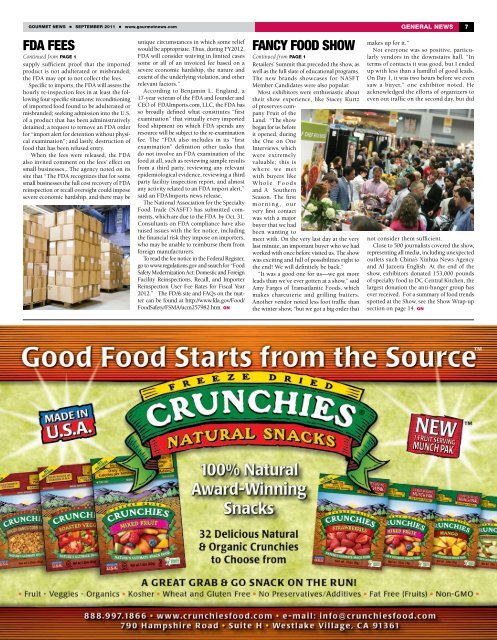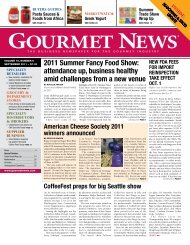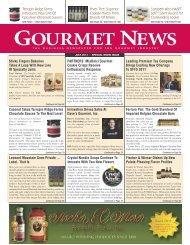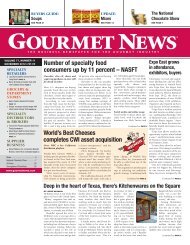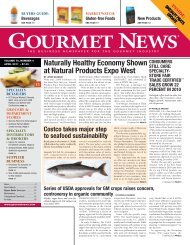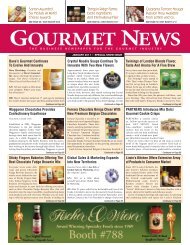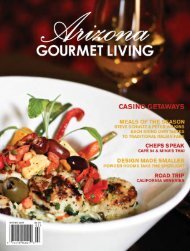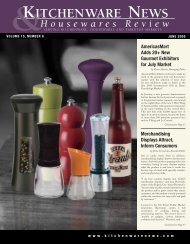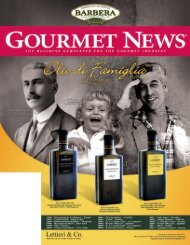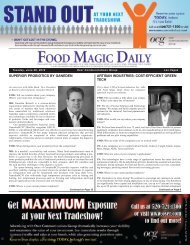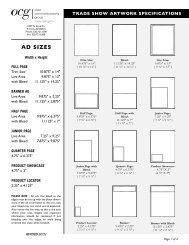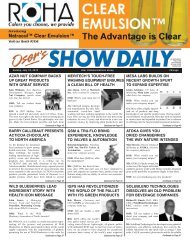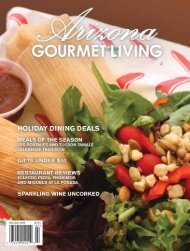2011 Summer Fancy Food Show - Oser Communications Group
2011 Summer Fancy Food Show - Oser Communications Group
2011 Summer Fancy Food Show - Oser Communications Group
Create successful ePaper yourself
Turn your PDF publications into a flip-book with our unique Google optimized e-Paper software.
GOURMET NEWS SEPTEMBER <strong>2011</strong> www.gourmetnews.com general NEWS 7<br />
FDA FEES<br />
Continued from Page 1<br />
supply sufficient proof that the imported<br />
product is not adulterated or misbranded,<br />
the FDA may opt to not collect the fees.<br />
Specific to imports, the FDA will assess the<br />
hourly re-inspection fees in at least the following<br />
four specific situations: reconditioning<br />
of imported food found to be adulterated or<br />
misbranded; seeking admission into the U.S.<br />
of a product that has been administratively<br />
detained; a request to remove an FDA order<br />
for “import alert for detention without physical<br />
examination”; and lastly, destruction of<br />
food that has been refused entry.<br />
When the fees were released, the FDA<br />
also invited comment on the fees’ effect on<br />
small businesses,. The agency noted on its<br />
site that “The FDA recognizes that for some<br />
small businesses the full cost recovery of FDA<br />
reinspection or recall oversight could impose<br />
severe economic hardship, and there may be<br />
unique circumstances in which some relief<br />
would be appropriate. Thus, during FY2012,<br />
FDA will consider waiving in limited cases<br />
some or all of an invoiced fee based on a<br />
severe economic hardship, the nature and<br />
extent of the underlying violation, and other<br />
relevant factors.”<br />
According to Benjamin L. England, a<br />
17-year veteran of the FDA and founder and<br />
CEO of FDAImports.com, LLC, the FDA has<br />
so broadly defined what constitutes “first<br />
examination” that virtually every imported<br />
food shipment on which FDA spends any<br />
resource will be subject to the re-examination<br />
fee. The “FDA also includes in its “first<br />
examination” definition other tasks that<br />
do not involve an FDA examination of the<br />
food at all, such as reviewing sample results<br />
from a third party, reviewing any relevant<br />
epidemiological evidence, reviewing a third<br />
party facility inspection report, and almost<br />
any activity related to an FDA import alert,”<br />
said an FDAImports news release.<br />
The National Association for the Specialty<br />
<strong>Food</strong> Trade (NASFT) has submitted comments,<br />
which are due to the FDA by Oct. 31.<br />
Consultants on FDA compliance have also<br />
raised issues with the fee notice, including<br />
the financial risk they impose on importers,<br />
who may be unable to reimburse them from<br />
foreign manufacturers.<br />
To read the fee notice in the Federal Register,<br />
go to www.regulations.gov and search for “<strong>Food</strong><br />
Safety Modernization Act: Domestic and Foreign<br />
Facility Reinspections, Recall, and Importer<br />
Reinspection User Fee Rates for Fiscal Year<br />
2012.” The FDA’s site and FAQs on the matter<br />
can be found at http://www.fda.gov/<strong>Food</strong>/<br />
<strong>Food</strong>Safety/FSMA/ucm257982.htm. gn<br />
FANCY FOOD SHOW<br />
Continued from Page 1<br />
Retailers’ Summit that preceded the show, as<br />
well as the full slate of educational programs.<br />
The new brands showcases for NASFT<br />
Member Candidates were also popular.<br />
Most exhibitors were enthusiastic about<br />
their show experience, like Stacey Kurtz<br />
of preserves company<br />
Fruit of the<br />
Land. “The show<br />
began for us before<br />
it opened, during<br />
the One on One<br />
Interviews, which<br />
were extremely<br />
valuable; this is<br />
where we met<br />
with buyers like<br />
Whole <strong>Food</strong>s<br />
and A Southern<br />
Season. The first<br />
m o r n i n g , o u r<br />
very first contact<br />
was with a major<br />
buyer that we had<br />
been wanting to<br />
meet with. On the very last day at the very<br />
last minute, an important buyer who we had<br />
worked with once before visited us. The show<br />
was exciting and full of possibilities right to<br />
the end! We will definitely be back.”<br />
“It was a good one for us—we got more<br />
leads than we’ve ever gotten at a show,” said<br />
Amy Farges of Transatlantic <strong>Food</strong>s, which<br />
makes charcuterie and grilling butters.<br />
Another vendor noted less foot traffic than<br />
the winter show, “but we got a big order that<br />
makes up for it.”<br />
Not everyone was so positive, particularly<br />
vendors in the downstairs hall. “In<br />
terms of contacts it was good, but I ended<br />
up with less than a handful of good leads.<br />
On Day 1, it was two hours before we even<br />
saw a buyer,” one exhibitor noted. He<br />
acknowledged the efforts of organizers to<br />
even out traffic on the second day, but did<br />
not consider them sufficient.<br />
Close to 500 journalists covered the show,<br />
representing all media, including unexpected<br />
outlets such China’s Xinhua News Agency<br />
and Al Jazeera English. At the end of the<br />
show, exhibitors donated 153,000 pounds<br />
of specialty food to DC Central Kitchen, the<br />
largest donation the anti-hunger group has<br />
ever received. For a summary of food trends<br />
spotted at the <strong>Show</strong>, see the <strong>Show</strong> Wrap-up<br />
section on page 14. gn


